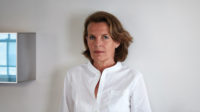For French architect Dominique Perrault, 2014 is off to an impressive start. Last month, he inaugurated two new projects—DC Tower 1 in Vienna and a Grand Theater for the small town of Albi in southern France. At the same time that his Paris-based firm is designing tall buildings and large developments throughout Europe and Asia, he’s taken on several prestigious projects in and around his home city. They include a new entrance pavilion for the Château de Versailles, the restoration of the legendary Longchamp Racecourse in Paris’s Bois de Boulogne park, and the transformation of the Poste du Louvre, encompassing an entire city block. Here, he talks about his latest works, his urban design strategy, and his “architecture of absence.”
Your DC Tower 1 in Vienna is now the tallest in Austria. Jean Nouvel completed a tower in Vienna a few years ago. But in New York, several supertall residential buildings—including one by your fellow countryman Christian de Portzamparc—have received plenty of backlash lately. Is there a turning of the tide, where the U.S. had historically always championed tall building and Europe had not, but now cities like Vienna and London are embracing it?
The situation in Europe concerns the mutation between the historic city and the switch to a metropolitan city. The example of Vienna is to develop a special skyline identity for the area around the historic center. The DC Tower is part of that skyline. It’s critical that the towers work together. This approach is [accepted by] the citizens because it is not, say, a solitary building for a single company. But it is also about program, not just location. It’s very important in Europe to have mixed-use functions like the DC Tower, with hotels, shops, offices, apartments, and public spaces. That approach is very positive because we have plenty of office spaces in our cities, but not enough living spaces. The DC project is in fact two towers. The second one will have more housing.
Your architecture has been described as one of presence and absence. On the smaller scale, you achieve this with voids in the landscape. On bigger projects it seems to be more about geometry—the very faceted façade of the Blade tower in Seoul, or the folded façades of the DC Towers.
There is always a relationship with the topography. In the EWHA University in Seoul (RECORD, November 2008, pg. 148) for example, that relationship is very strong. The DC towers in Vienna overlook the Danube, and the folded façade is a reflection of the surface of the water. But it is also part of an urban strategy. We wanted to create a public space that is very spiritual, very specific. The concept was that the two towers stem from a monolith, and the act of breaking that monolith creates a void between the towers that acts as a piazza and entrance gate to the rest of the district.
Your DC Tower 1 opened the same week last month as your theater in Albi, France. Albi is a city that not many people outside of France have probably heard of, yet it is a UNESCO World Heritage site. Were there historic implications for your design?
Albi is a small historic city, but very choreographed. It is becoming better known now since being added to the UNESCO list [in 2010]. It has an absolutely unbelievable cathedral, a masterpiece really. There is also a great museum of Toulouse-Lautrec. The new theater is just at the gate of the historic district. We echoed the traditional materials of Albi, especially the pink brick, in our building. We then wrapped the building with a curving metal fabric that acts like a scarf, protecting the building against the sun but also creating a lyrical feeling. It’s a scenographic design outside of the stage that makes the presence of the building very alive as it shimmers in the sun and changes color.
It has been almost 20 years since you completed the French National Library in Paris, with its four L-shaped towers defining the corners of a hollowed out esplanade. It was controversial but also a defining project for you. Now you just completed a new East Entrance there that includes commercial development and movie theaters. What is it like to revisit a project so many years later?
This project created a big void in the city. In the beginning, everybody thought it was crazy to put a big void in the middle of nowhere, but now this space is a unique public, open area along the banks of the Seine in the East of Paris. This urban strategy has a strong message about the position of architecture in the social fabric of the city. Back then nothing existed around there, but now it is a real district—very intense and high density. We were able to do this small project at the entrance as a result of the developing district around it.
Do you continue to work on small projects?
We are doing a very small project, but it is a very prestigious one. It is a new entrance pavilion at the Château de Versailles. It has echoes of the Pyramide du Louvre by I.M. Pei. Work on the site is starting and we expect to finish by spring of next year. But we also are working on a very big project. We are transforming and renovating the Poste du Louvre, the main post office of Paris. It is a huge block built by Julien Guadet at the end of the 19th century. Part of it will remain a post office, but the rest will be offices and social housing.
You’ve only completed one project in the United States, a small factory in Maryland. Would you like to do more?
Yes, I’m just waiting for the right opportunity.













